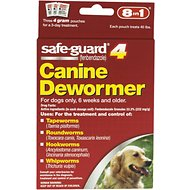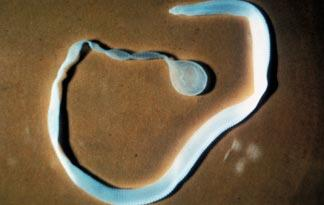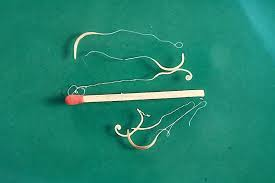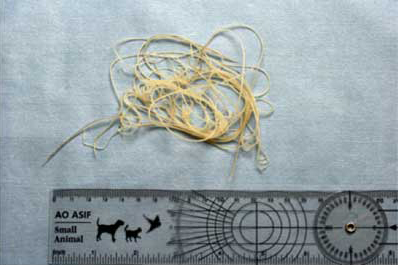How Do Dogs Get Worms?
Quick Guide
Like most animals, dogs can be host to many different kinds of worms.
There are several common kinds of worms that your dog might have, but how do dogs get worms to begin with?
The most common way for dogs to get worms is to ingest them through self-grooming or grooming another pet. Worms are found in stool or soil and as such are easily harbored in materials and substances that come into contact with a dogs tongue during licking or eating.
Although each worm is slightly different there are all-in-one preventative treatments that are effective in keeping your dog safe from most worms.
Just be sure to use all medication as directed for maximum effectiveness.
Best Dog Dewormer

Available for small, medium, and large dogs, SafeGuard canine dewormer tackles all of the major worms that dogs obtain. It effectively controls the worms for up to 6 months when used as directed (3 consecutive days of administration).
Unlike other products SafeGuard is an all-in-one solution that has gotten great reviews from owners looking to treat a number of different worms.
Roundworms in dogs
Also called Ascarids, roundworms inhabit the dog’s digestive tract. They are very common in dogs. In fact, most puppies have roundworms unless special steps have been taken to make sure the mother doesn’t have them before the puppies are born. Roundworms exist all over North America. Not only can they be harmful to dogs, but they can also cause disease in humans.
Adult roundworms live in the small intestine and an animal that has roundworms can pass millions of eggs in their feces each day. There are several different kinds of roundworms but, in general, an animal eats the eggs (in the feces or by eating an animal that has eaten the feces) and they hatch in the dog’s intestines. Roundworms can become “encysted” in the tissues of the dog and, in the case of a female dog, when she is pregnant she can pass the larvae along to her unborn puppies. Larvae can also be passed along to puppies through the mammary glands when puppies nurse. This explains why so many puppies have roundworms. Even if the mother does not show any signs of having roundworms, they can be dormant in her tissues. In order to get rid of these dormant roundworms before puppies are conceived, it is necessary to treat the mother with a special wormer you can obtain from your veterinarian.
Roundworms are harmful because they absorb nutrients from the dog’s digestive tract. They can also prevent proper digestion and damage the lining of the intestines. In severe cases a dog may exhibit vomiting, diarrhea, and constipation. Roundworms in the lungs can cause a cough.
Roundworms are typically 3-4 inches long, though some can be as long as 7 inches. Your vet can easily identify roundworm eggs with a fecal exam. A puppy or dog will sometimes vomit roundworms and they will look like spaghetti. Adult roundworms are easy to kill with one of several wormers. There is usually a wormer that kills roundworms included in monthly heartworm preventives such as Heartgard Plus. If you plan to breed your female dog, talk to your vet about treating her to make sure you get rid of any encysted roundworms first.
Also Read: Visiting a Pet Expo with Your Dog
Hookworms in dogs
Hookworms are another very common parasite found in dogs, especially in puppies. They can cause serious diarrhea and disease such as anemia. Hookworms can have cutting plates that they use to attach themselves to the walls of the intestines to feed on the dog’s blood or structures like teeth. Hookworms can also affect people, leading to skin disease, abdominal pain, and infections in the intestines.
There are several kinds of hookworms, affecting different animals – though the dog can be a host to most of them. They are found all over North America. Dogs can be infected in one of several ways: by eating larvae from soil or water that has been contaminated; by eating a transport host that has been infected (another animal that has hookworms); if the hookworm larvae penetrates their skin; or if larvae infects unborn puppies in the uterus or young puppies when they are nursing.
Adult hookworms attach themselves to the walls of the intestines and live on the blood of their host. The dog (or other animal) can become anemic if they have a heavy infestation. The hookworms lay eggs that are passed out of the body. In a few days the eggs hatch and the larvae emerge. They wait for a host animal to ingest them in water or the soil or by getting into the skin of the animal. Once inside the body of their host (in this case a dog), some of the hookworms will burrow into the tissues and become dormant. In a pregnant animal they will wait until they can infect the fetuses or go to the mammary glands and wait until they can infect puppies when they nurse. Puppies will either be born with hookworms or ingest them when they nurse.
If your dog appears anemic or if you think he has hookworms, you should see your vet. Hookworm eggs are very tiny and they can be hard to detect. Your dog may exhibit symptoms of illness before you ever see any eggs, especially in puppies. Most vets will start puppies on a worming schedule when they are a few weeks old that will eliminate most common worms, including hookworms. Or you can purchase a good wormer yourself and worm your puppies or dog at home. Be sure to follow the directions exactly.
For adult dogs, most heartworm preventatives contain a wormer that will eliminate hookworms on a monthly basis. However, they only kill adult hookworms and not encysted hookworms.
Tapeworms in dogs
Tapeworms are very common in dogs. These segmented worms usually break apart and look like grains of rice if you see them in your dog’s feces. Tapeworms can have a number of intermediate hosts but the most common source of tapeworms in dogs is the flea. This kind of adult tapeworm can grow to be up to 20 inches long. It lives in the dog’s small intestine. As it grows, the ends will break off and are passed in the dog’s feces. Each of the segments is full of eggs. When they are outside the body and eaten by fleas, they grow in the flea’s body. If a dog eats the flea – when it is biting him, for example – it starts the cycle again.
The most common sign of tapeworms is to find the small segments around your dog’s tail or in his feces. In a severe infestation your dog may have stomach cramping or vomiting. Some dogs will scoot on the floor if the segments are still actively moving around their anus.
Tapeworms can be a danger to humans, especially children, if they eat any of the flea larvae. They can exhibit the same kind of symptoms that dogs exhibit – stomach cramping and vomiting or diarrhea. In some cases they will have itching around their bottoms.
Flea control is the best way of preventing tapeworms. There are also several good wormers that will kill tapeworms. Talk to your vet about wormers to use for your dog.
Whipworms in dogs
Whipworms are the fourth major kind of worm that are commonly found in dogs. They can be found throughout North America. They are called “whipworms” because the worms have a whip-like shape. The front part of the worm is thin, like a whip, and the end of the worm is thick like the handle of a whip. Whipworms can be found in the dog’s large intestine and in the cecum. The cecum is the place where the large and small intestines join.
A dog becomes infected with whipworms by consuming food or water that contains whipworm eggs. After the dogs swallows them, they hatch and in less than 12 weeks the whipworm larvae become adults in the dog’s large intestine and cecum. There the whipworms feed on the dog’s blood by burrowing their heads in the wall of the intestine. They lay eggs which are passed out of the body in the dog’s feces. The eggs have to stay in the soil for about a month to mature so they can start the life cycle over again.
Whipworms are diagnosed by finding their eggs in the dog’s feces. They don’t usually produce a lot of eggs so it is sometimes necessary to have more than one fecal exam to find them. Indications that your dog has whipworms can be hard to detect sometimes. If he only has a few whipworms he may not show any symptoms. However, if he has a heavy infestation, he will probably have an inflammation of the intestinal wall. He can lose weight or have diarrhea. Some dogs will have hemorrhaging in the intestine.
It can be difficult to get rid of whipworm eggs once they are in the soil. They can survive for years. Even freezing doesn’t kill them. If your property has had a whipworm infestation, it helps to replace the soil and keep your dog away from the contaminated area. You should also pick up your dog’s feces on a daily basis.
These are the most common worms found in dogs, along with heartworms.
Heartworms in dogs
Heartworms are transmitted somewhat differently. They are spread by mosquitoes that bite an infected animal, incubate the microfilariae in their bodies, and then bite a dog, passing the larvae to his bloodstream. In a short time the larvae will grow to adult heartworms and make their way to the dog’s lungs and heart. Unless they are killed by heartworm preventive or treatment, they will reproduce and grow so large in the dog’s heart that they will kill him. Heartworm preventives are very effective when they are used as directed. Talk to your veterinarian about the best heartworm preventive for your dog. Most dog owners choose a monthly preventive. Heartworms are now found in all 50 states.
Unfortunately, there is not one single wormer that will kill every kind of worm found in dogs but if you give your dog a monthly heartworm preventive and see your vet once a year, you should be able to keep your dog free of worms. Although the worms discussed here can be harmful to dogs if they are left untreated, it is very easy to get rid of them.
















